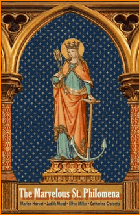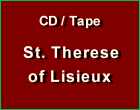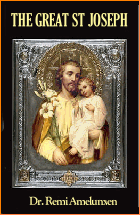Symbolism
 |
 |
 |
 |
 |
 |
 |
Adam, Eve & the Paradise Tree
What is the origin of the delightful custom of the Christmas tree?
I am happy to state definitively that it had nothing to do with the heresiarch Martin Luther, who is often reported to have set up the first Christmas tree. There is absolutely no scholarly basis for this legend. It is just another Protestant attempt to steal from the Catholics and deny the enormous legacy of good that came from the Middle Ages.
 For the roots of the Christmas tree are medieval, and it is the Germans, with their innate sense of the innocence of Christmas, who spread the custom. Let me tell the true story.
For the roots of the Christmas tree are medieval, and it is the Germans, with their innate sense of the innocence of Christmas, who spread the custom. Let me tell the true story.
Christmas Eve is the feast day of our first parents, Adam and Eve, who are commemorated as Saints in the calendars of the Catholic churches of Eastern rites. Their veneration spread also to the West and became very popular toward the end of the first millennium. Although the Latin rite of the Catholic Church never officially introduced their feast, it did not oppose their popular veneration. In many old churches of Europe their statues may still be seen among the images of the Saints.
Around the 12th century the custom began of celebrating this feast on December 24 with the Paradise Play, which became one of the most popular medieval mystery plays. The Paradise Play depicted the story of the creation of Adam and Eve, their sin and their banishment from Paradise. The play ended with the promise of the coming Savior and His incarnation.
One of the few props in the play was a large evergreen tree called a Paradise Tree, its branches laden with red apples.
The Germans enter the picture
With the rise of Humanism, Renaissance and Protestant Revolution the customs of performing the Paradise Play vanished. In fact, Germany had no theater for several centuries. But the German Catholics did not abandon the Paradise tree.
There, it became the custom to put up a “paradise tree” in the home to honor the first parents. This was a fir tree laden with apples, the symbol of Adam’s fall. They also decorated the tree with white wafers, representing the Eucharist, the symbol of man’s redemption and salvation. It was customary as early as the 16th century in Germany to ring the tree with candles because the Paradise Play was enacted in such a ring. (1)
 In fact, we find first mention of the Christmas tree as early as 1419 at the Freiburg Fraternity Baker’s Apprentices of the German Alsace. We also have a letter written by a Strasbourg resident in 1605 who describes the established custom, "At Christmas they set up fir trees in the parlors at Strasburg and hang thereon roses cut of many-colored paper, apples, wafers, gold-foil, sweets.” (2)
In fact, we find first mention of the Christmas tree as early as 1419 at the Freiburg Fraternity Baker’s Apprentices of the German Alsace. We also have a letter written by a Strasbourg resident in 1605 who describes the established custom, "At Christmas they set up fir trees in the parlors at Strasburg and hang thereon roses cut of many-colored paper, apples, wafers, gold-foil, sweets.” (2)
Until the 19th century, mostly edible items were used as tree decorations. Then, in 1880 glassmakers in Thuringia, Germany, discovered how to make blown glass balls and bells, and these soon replaced the apples.
The custom spread naturally. From the Alsace the tree made its way to other regions of Germany and France. German settlers and soldiers brought the Christmas tree to America in the colonial period. The German born Queen Victoria formally introduced the Christmas tree in England in 1841 where it was warmly received, and soon the English were pretending that it was their idea, as is their habit.
Thus, we find the roots of our modern Christmas tree: It is actually the medieval Paradise tree, a reminder of the fall of our first parents and the promise of the coming of a Savior.
Other Adam tidbits
In addition to our Christmas tree, we owe many expressions in our language to Adam.
When we speak of "the old Adam" in us, we mean that part of us that tends to yield to temptation.
When St. Paul speaks of "the last Adam" (1 Cor 15:45) he means Christ, who by his obedience repaired the disobedience of the first Adam.
Since God ordered Adam to till the ground after his expulsion from Eden, gardening is called "Adam's profession," and in fact Adam became a Patron Saint of gardeners.
Lastly, that prominent cartilage in the human throat, especially the male throat, is called "Adam's apple" on the theory that one piece of the forbidden apple stuck in Adam's throat and we have all inherited a visible mark of his sin.

I am happy to state definitively that it had nothing to do with the heresiarch Martin Luther, who is often reported to have set up the first Christmas tree. There is absolutely no scholarly basis for this legend. It is just another Protestant attempt to steal from the Catholics and deny the enormous legacy of good that came from the Middle Ages.

The Paradise Tree was one of the most popular medieval mystery plays
Christmas Eve is the feast day of our first parents, Adam and Eve, who are commemorated as Saints in the calendars of the Catholic churches of Eastern rites. Their veneration spread also to the West and became very popular toward the end of the first millennium. Although the Latin rite of the Catholic Church never officially introduced their feast, it did not oppose their popular veneration. In many old churches of Europe their statues may still be seen among the images of the Saints.
Around the 12th century the custom began of celebrating this feast on December 24 with the Paradise Play, which became one of the most popular medieval mystery plays. The Paradise Play depicted the story of the creation of Adam and Eve, their sin and their banishment from Paradise. The play ended with the promise of the coming Savior and His incarnation.
One of the few props in the play was a large evergreen tree called a Paradise Tree, its branches laden with red apples.
The Germans enter the picture
With the rise of Humanism, Renaissance and Protestant Revolution the customs of performing the Paradise Play vanished. In fact, Germany had no theater for several centuries. But the German Catholics did not abandon the Paradise tree.
There, it became the custom to put up a “paradise tree” in the home to honor the first parents. This was a fir tree laden with apples, the symbol of Adam’s fall. They also decorated the tree with white wafers, representing the Eucharist, the symbol of man’s redemption and salvation. It was customary as early as the 16th century in Germany to ring the tree with candles because the Paradise Play was enacted in such a ring. (1)

Christmas in Germany, 1881
Until the 19th century, mostly edible items were used as tree decorations. Then, in 1880 glassmakers in Thuringia, Germany, discovered how to make blown glass balls and bells, and these soon replaced the apples.
The custom spread naturally. From the Alsace the tree made its way to other regions of Germany and France. German settlers and soldiers brought the Christmas tree to America in the colonial period. The German born Queen Victoria formally introduced the Christmas tree in England in 1841 where it was warmly received, and soon the English were pretending that it was their idea, as is their habit.
Thus, we find the roots of our modern Christmas tree: It is actually the medieval Paradise tree, a reminder of the fall of our first parents and the promise of the coming of a Savior.
Other Adam tidbits
In addition to our Christmas tree, we owe many expressions in our language to Adam.
When we speak of "the old Adam" in us, we mean that part of us that tends to yield to temptation.
When St. Paul speaks of "the last Adam" (1 Cor 15:45) he means Christ, who by his obedience repaired the disobedience of the first Adam.
Since God ordered Adam to till the ground after his expulsion from Eden, gardening is called "Adam's profession," and in fact Adam became a Patron Saint of gardeners.
Lastly, that prominent cartilage in the human throat, especially the male throat, is called "Adam's apple" on the theory that one piece of the forbidden apple stuck in Adam's throat and we have all inherited a visible mark of his sin.
- Tristam Potter Coffin, The Illustrated Book of Christmas Folklore, Seabury Press, 1974, pp.18-19
- B. Brunner, Inventing the Christmas Tree, Yale University Press, p. 3

Posted December 17, 2014
______________________
______________________











